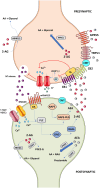The Role of Cannabinoids in CNS Development: Focus on Proliferation and Cell Death
- PMID: 35925507
- PMCID: PMC11412427
- DOI: 10.1007/s10571-022-01263-y
The Role of Cannabinoids in CNS Development: Focus on Proliferation and Cell Death
Abstract
The active principles of Cannabis sativa are potential treatments for several diseases, such as pain, seizures and anorexia. With the increase in the use of cannabis for medicinal purposes, a more careful assessment of the possible impacts on embryonic development becomes necessary. Surveys indicate that approximately 3.9% of pregnant women use cannabis in a recreational and/or medicinal manner. However, although the literature has already described the presence of endocannabinoid system components since the early stages of CNS development, many of their physiological effects during this stage have not yet been established. Moreover, it is still uncertain how the endocannabinoid system can be altered in terms of cell proliferation and cell fate, neural migration, neural differentiation, synaptogenesis and particularly cell death. In relation to cell death in the CNS, knowledge about the effects of cannabinoids is scarce. Thus, the present work aims to review the role of the endocannabinoid system in different aspects of CNS development and discuss possible side effects or even opportunities for treating some conditions in the development of this tissue.
Keywords: Apoptosis; Cannabinoids; Cell death; Development; Endocannabinoids; Proliferation.
© 2022. The Author(s), under exclusive licence to Springer Science+Business Media, LLC, part of Springer Nature.
Conflict of interest statement
The authors have no financial interests to disclose.
Figures




Similar articles
-
The evolution of cannabinoid receptors in cancer.WIREs Mech Dis. 2023 Jul-Aug;15(4):e1602. doi: 10.1002/wsbm.1602. Epub 2023 Feb 7. WIREs Mech Dis. 2023. PMID: 36750231 Free PMC article. Review.
-
Role of Cannabinoids in Various Diseases: A Review.Curr Pharm Biotechnol. 2022;23(11):1346-1358. doi: 10.2174/1389201023666211223164656. Curr Pharm Biotechnol. 2022. PMID: 34951355 Review.
-
Endocannabinoid System: A Multi-Facet Therapeutic Target.Curr Clin Pharmacol. 2016;11(2):110-7. doi: 10.2174/1574884711666160418105339. Curr Clin Pharmacol. 2016. PMID: 27086601 Review.
-
From Phytocannabinoids to Cannabinoid Receptors and Endocannabinoids: Pleiotropic Physiological and Pathological Roles Through Complex Pharmacology.Physiol Rev. 2016 Oct;96(4):1593-659. doi: 10.1152/physrev.00002.2016. Physiol Rev. 2016. PMID: 27630175 Review.
-
The Endocannabinoid System: A Potential Target for the Treatment of Various Diseases.Int J Mol Sci. 2021 Aug 31;22(17):9472. doi: 10.3390/ijms22179472. Int J Mol Sci. 2021. PMID: 34502379 Free PMC article. Review.
Cited by
-
The Healthy and Diseased Retina Seen through Neuron-Glia Interactions.Int J Mol Sci. 2024 Jan 17;25(2):1120. doi: 10.3390/ijms25021120. Int J Mol Sci. 2024. PMID: 38256192 Free PMC article. Review.
-
Cannabinoids: Role in Neurological Diseases and Psychiatric Disorders.Int J Mol Sci. 2024 Dec 27;26(1):152. doi: 10.3390/ijms26010152. Int J Mol Sci. 2024. PMID: 39796008 Free PMC article. Review.
References
-
- Alexandre J, Carmo H, Carvalho F, Silva JP (2020) Synthetic cannabinoids and their impact on neurodevelopmental processes. Addict Biol 25(2):1–12. 10.1111/adb.12824wileyonlinelibrary.com/journal/adb - PubMed
-
- Almada M, Alves P et al (2020a) Synthetic cannabinoids JWH-018 JWH-122 UR-144 and the phytocannabinoid THC activate apoptosis in placental cells. Toxicol Lett 319(June 2019):129–37. 10.1016/j.toxlet.2019.11.004 - PubMed
-
- Amlani A et al (2017) Maternal cannabinoid use alters cannabinoid (CB1) and endothelin (ETB) receptor expression in the brains of dams but not their offspring. Dev Neurosci 39(6):498–506. 10.1159/000480453 - PubMed
Publication types
MeSH terms
Substances
LinkOut - more resources
Full Text Sources

